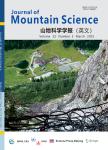Evaluation of soil erodibility factor(k)for loess derived landforms of Kechik watershed in Golestan Province,North of Iran
Evaluation of soil erodibility factor(k) for loess derived landforms of Kechik watershed in Golestan Province, North of Iran作者机构:Dept.of Soil ScienceGorgan university of agricultural sciences and natural resourcesGorgan ***Iran Natural resources organization of Golestan provinceGorgan ***Iran
出 版 物:《Journal of Mountain Science》 (山地科学学报(英文))
年 卷 期:2016年第13卷第11期
页 面:2028-2035页
核心收录:
学科分类:082802[工学-农业水土工程] 090707[农学-水土保持与荒漠化防治] 0907[农学-林学] 08[工学] 0828[工学-农业工程] 09[农学] 0815[工学-水利工程]
基 金:supported by GUASNR(90298-13)research project
主 题:Soil erodibility Loess Wischmeier nomograph Iran
摘 要:The technique proposed by Wischmeier & Smith for estimating the soil erodibility factor is among the most important methods in this regard. Given the high amounts of silt and lime content in loess soils of eastern parts of Golestan province in Iran, this study aims to evaluate the ability of Wischmeier & Smith index to estimate the soil erodibility of this region. Soil erodibility was first obtained by Wischmeier nomograph and then was compared with the actual values obtained by selecting six plots and then performing physical and chemical tests on these samples. Using the nomograph, Wischmeier index was calculated to be about 0.05-0.092 Mg h MJ?1 mm?1. The results showed that Wischmeier index was 182, 4.11, 6 and 0.35 times than actual value in field with half-hour rainfall, Fournier index, SWAT value with half-hour rainfall and SWAT value with Fournier index, respectively. Obtained results showed that erodibility estimated by Wischmeier & Smith index was higher than the actual measured value. Poor performance of this index in loess soils indicates the need for further research in this field.




